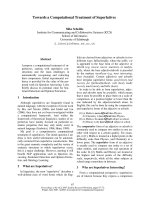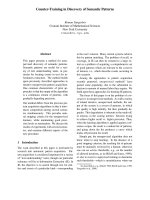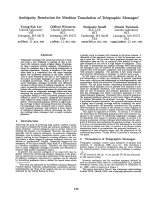Báo cáo khoa học: "TOWARD A COMPUTATIONAL THEORY OF SPEECH PERCEPTION " doc
Bạn đang xem bản rút gọn của tài liệu. Xem và tải ngay bản đầy đủ của tài liệu tại đây (80.77 KB, 2 trang )
TOWARD A COMPUTATIONAL THEORY OF SPEECH PERCEPTION
Jonathan Allen
Research Laboratory of Electronics & Dept. of Electrical Engineering and Computer Science
Massachusetts Institute of Technology, Cambridge, MA 02139
ABSTRACT
In recent years,a great deal of evidence has been collec-
ted which gives substantially increased insight into the
nature of human speech perception. It is the author's
belief that such data can be effectively used to infer
much of the structure of a practical speech recognition
system. This paper details a new view of the role of
structural constraints within the several structural do-
mains (e.g. articulation, phonetics, phonology, syntax,
semantics) that must be utilized to infer the desired
percept.
Each of the structural domains mentioned above has a sub-
stantial "internal theory" describing the constraints
within that domain, but there are also many interactions
between structural domains which must be considered.
Thus words llke "incline" and "survey" shift stress with
syntactic role, and there is a pragmatic bias for the
ambiguous sentence "John called the boy who has smashed
his car up." to be interpreted under a strategy that
reflects a tendency for local completion of syntactic
structures. It is clear, then, that while analysis
within a structural domain (e.g. syntactic parsing) can
be performed up to a point,lnteraction with other domains
and integration of constraint strengths across these
domains is needed for correct perception. The various
constraints have differing and changing strengths at
different points in an utterance, so that no fixed metric
can be used to determine their contribution to the well-
formedness of the utterance.
At the segmental level, many diverse cues for segmental
features have been found. As many as 16 cues mark the
voicing distinction, for example. We may think of each
of these cues as also representing a constraint, and the
strength of the constraint varies with the context. For
example, stop closure duration must be interpreted in the
context of the local rate of speech, and a given value
of closure duration can signify either a voiced or an
unvoiced stop depending on the surrounding vowel dura-
tions. Thus several cues must be integrated to obtain
the perceived segmental feature, and the weights assigned
to each cue vary with the local context.
From the preceding examples, it is seen that in order to
model human speech perception, it is necessary to dyna-
mically integrate a wide variety of constraints. The
evidence argues strongly for an active focussed search,
whereby the perceptual mechanism knows, as the utterance
unfolds, where the strongest constraint strengths are,
and uses this reliable information, while ignoring
"cues" that are unreliable or non-determining in the
immediate context. For example, shadowing experiments
have shown that listeners (performing the shadowing
task) can restore disrupted words to their original form
by using semantic and syntactic context, thus demonstra-
ting the integration process. Furthermore, techniques
are now available for analytically finding that infor-
matlon in an input stimulus which can maximally discri-
mlnate between two candidate prototypes, so that the
perceptual
control structure
can
focus only on such
information co make a choice between the candidates.
In this paper, we develop a theory for speech recogni-
tion which contains the required dynamic integration
capability coupled with the ability
to
focus on a res-
tricted
set of cues which has been contextually
selected.
The model of speech recognition which we have developed
requires, of course, an initial low-level analysis of
the speech waveform to get started. We argue from the
recent psychollnguistic literature that stressed
syllables provide the required entry points. Stressed
syllable peaks can be readily located, and use of the
phonotactics of segmental distribution within syllables,
together with the relatively clear articulation of
syllable-initial consonants, allows us to formulate a
robust procedure for determining initial segmental
"islands", around which further analysis can proceed.
In fact, there is evidence to indicate that the human
lexicon is organized and accessed via
these
stressed
syllables. The restriction of the original analysis to
these stressed syllables can be regarded as another form
of focussed search, which in turn leads to additional
searches dictated by the relative constraint strengths
of the various domains contributing to the percept. We
argue that these views are not only consonant with the
current knowledge of human speech perceptlon, but form
the proper basis for the design of hlgh-performance
Speech recognition systems.
17









